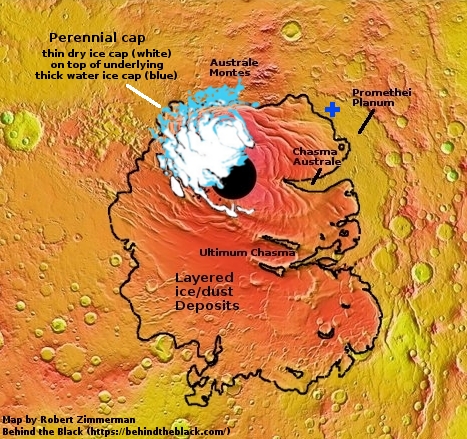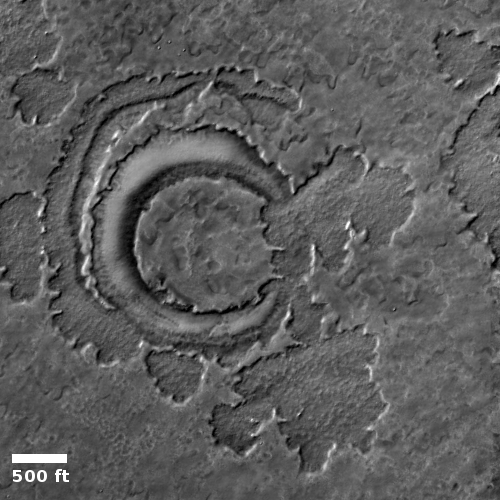Cryptic Terrain on Mars
Cool image time! The photo to the right, rotated and cropped to post here, was taken on September 27, 2020 by the high resolution camera on Mars Reconnaissance Orbiter (MRO). It shows what is likely a crater that is partly buried by ice and dust and sand near or on the edge of Mars’s south polar ice cap.
It also shows an example of what planetary scientists have dubbed “cryptic terrain,” found generally on the margins of that ice cap. In this case, the location is on a plateau adjacent to the ice cap dubbed Promethei Planum. Despite a lot of searching, I could not locate any research papers describing Promethei Planum, though data outlined in one Mars Express press release from 2008 suggested it was part of the polar ice cap more than two miles thick that is covered by a thin mantle of dry ice each winter.
The strange curlicue cliffs and plateaus seen here are thought to form as part of the arrival and then sublimation away of that seasonal dry ice mantle, but how that process exactly works to create these particular geological features remains I think a mystery. North is to the top. The general grade is also downhill away from the icecap to the north.
Moreover, the overview map below, with the location of this image indicated by the blue cross, illustrates more mysteries.

For some reason Promethei Planum is not considered to be part of the layered ice/dust deposits that comprise most of the southern ice cap. Yet, this plateau clearly has layers, as shown in the image above, is made up of ice, as the Mars Express data suggests, and is covered with dust and debris. Why it is excluded from that layered ice/dust cap is not evident to me.
The crater itself apparently occurred on deeper and older layers that were subsequently covered, filling the crater with ice and debris. The seasonal coming and going of that dry ice mantle is now causing the removal of the top layers, once again exposing that crater and its rim to the surface. This is also revealing that some geological process in the past also caused a break in the crater’s eastern rim.
The geology here really is alien to Earth and a mystery at present. There are theories to explain it, but I think none is satisfactory. We just don’t know enough.
On Christmas Eve 1968 three Americans became the first humans to visit another world. What they did to celebrate was unexpected and profound, and will be remembered throughout all human history. Genesis: the Story of Apollo 8, Robert Zimmerman's classic history of humanity's first journey to another world, tells that story, and it is now available as both an ebook and an audiobook, both with a foreword by Valerie Anders and a new introduction by Robert Zimmerman.
The print edition can be purchased at Amazon or from any other book seller. If you want an autographed copy the price is $60 for the hardback and $45 for the paperback, plus $8 shipping for each. Go here for purchasing details. The ebook is available everywhere for $5.99 (before discount) at amazon, or direct from my ebook publisher, ebookit. If you buy it from ebookit you don't support the big tech companies and the author gets a bigger cut much sooner.
The audiobook is also available at all these vendors, and is also free with a 30-day trial membership to Audible.
"Not simply about one mission, [Genesis] is also the history of America's quest for the moon... Zimmerman has done a masterful job of tying disparate events together into a solid account of one of America's greatest human triumphs."--San Antonio Express-News
Cool image time! The photo to the right, rotated and cropped to post here, was taken on September 27, 2020 by the high resolution camera on Mars Reconnaissance Orbiter (MRO). It shows what is likely a crater that is partly buried by ice and dust and sand near or on the edge of Mars’s south polar ice cap.
It also shows an example of what planetary scientists have dubbed “cryptic terrain,” found generally on the margins of that ice cap. In this case, the location is on a plateau adjacent to the ice cap dubbed Promethei Planum. Despite a lot of searching, I could not locate any research papers describing Promethei Planum, though data outlined in one Mars Express press release from 2008 suggested it was part of the polar ice cap more than two miles thick that is covered by a thin mantle of dry ice each winter.
The strange curlicue cliffs and plateaus seen here are thought to form as part of the arrival and then sublimation away of that seasonal dry ice mantle, but how that process exactly works to create these particular geological features remains I think a mystery. North is to the top. The general grade is also downhill away from the icecap to the north.
Moreover, the overview map below, with the location of this image indicated by the blue cross, illustrates more mysteries.

For some reason Promethei Planum is not considered to be part of the layered ice/dust deposits that comprise most of the southern ice cap. Yet, this plateau clearly has layers, as shown in the image above, is made up of ice, as the Mars Express data suggests, and is covered with dust and debris. Why it is excluded from that layered ice/dust cap is not evident to me.
The crater itself apparently occurred on deeper and older layers that were subsequently covered, filling the crater with ice and debris. The seasonal coming and going of that dry ice mantle is now causing the removal of the top layers, once again exposing that crater and its rim to the surface. This is also revealing that some geological process in the past also caused a break in the crater’s eastern rim.
The geology here really is alien to Earth and a mystery at present. There are theories to explain it, but I think none is satisfactory. We just don’t know enough.
On Christmas Eve 1968 three Americans became the first humans to visit another world. What they did to celebrate was unexpected and profound, and will be remembered throughout all human history. Genesis: the Story of Apollo 8, Robert Zimmerman's classic history of humanity's first journey to another world, tells that story, and it is now available as both an ebook and an audiobook, both with a foreword by Valerie Anders and a new introduction by Robert Zimmerman.
The print edition can be purchased at Amazon or from any other book seller. If you want an autographed copy the price is $60 for the hardback and $45 for the paperback, plus $8 shipping for each. Go here for purchasing details. The ebook is available everywhere for $5.99 (before discount) at amazon, or direct from my ebook publisher, ebookit. If you buy it from ebookit you don't support the big tech companies and the author gets a bigger cut much sooner.
The audiobook is also available at all these vendors, and is also free with a 30-day trial membership to Audible.
"Not simply about one mission, [Genesis] is also the history of America's quest for the moon... Zimmerman has done a masterful job of tying disparate events together into a solid account of one of America's greatest human triumphs."--San Antonio Express-News



Apparently, not all the Cubs fans move to Arizona for retirement.